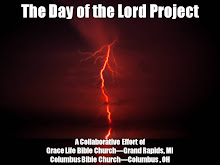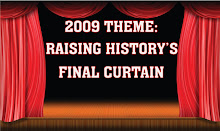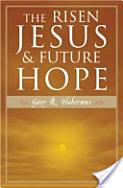The Incredible Accuracy of Luke
In last week's posting, we demonstrated by comparing scripture with scripture, that the book of Acts was the second part of a two part history addressed to Theophilus. In Luke 1:1-3, we read the following:
Forasmuch as many have taken in hand to set forth in order a declaration of those things which are most surely believed among us, 2) Even as they delivered them unto us, which from the beginning were eyewitnesses, and ministers of the word; 3) It seemed good to me also, having had perfect understanding of all things from the very first, to write unto thee in order, most excellent Theophilus,
A careful reading of this passage ought to highlight the following points. First, Luke interviewed eyewitnesses who were present from the beginning of the events recorded. Second, Luke's goal is to present a chronological record of the events as they were commonly believed. While the Gospel of Luke is written to present Christ as the son of man, it also doubles as a chronological history of the life of Christ. When coupled with Acts, the Gospel of Luke takes its reader from the annunciation of the Christ's birth all the way through to Paul imprisonment in Rome in Acts 28. Considering that Luke did not write by his own will or in his own words, but rather the words of God under the inspiration of the Holy Spirit,(1) the foolishness of doubting these events becomes clear.
Despite the insatiable cries of Biblical skeptics and correctors, Luke's reliability as a historian is unquestionable. Merrill Unger, author of Archaeology and the New Testament, informs his readers that archeology has authenticated the gospel accounts, particularly the writings of Luke. Commenting on the book of Acts, Unger writes, "The Acts of the Apostles is now generally agreed in scholarly circles to be the work of Luke, to belong to the first century and to involve the labors of a careful historian who was substantially accurate in his use of sources."(2) Likewise, after conducting thirty years of research into the accuracy of Luke's writings, historian Sir William Ramsay concluded that, "Luke is a historian of the first rank; not merely are his statements of fact trustworthy. . .this author should be placed along with the very greatest historians."(3)
Classical scholar and Roman historian Colin Hemer chronicles Luke's accuracy as a historian in his landmark book, The Book of Acts in the Setting of Hellenistic History. Hemer identifies eighty-four facts in the last sixteen chapters of Acts that have been confirmed by historical and archeological research:
- the natural crossing between correctly named ports (Acts 13:4-5)
- the proper port (Perga) along the direct destination of a ship crossing from Cyprus (13:13)
- the proper location of Lycaonia (Acts 14:6)
- the unusual but correct declension of the name Lystra (14:6)
- the correct language spoke in Lystra—Lycaonian (14:11)
- to god known to be so associated-Jupiter and Mercurious (14:12)
- the proper port, Attalia, which returning travelers would use (14:25)
- the correct order of approach to Derbe and then Lystra from the Cilician Gates (16:1, cf. 15:41)
- the proper form of the name Troas (16:8)
- the place of a conspicuous sailors' landmark, Samothrace (16:11)
- the proper description of Philippi as a Roman colony (16:12)
- the right location of the river (Gangites) near Philippi (16:13)
- the proper association of Thyatira as a center of dyeing (16:14)
- correct designations for the magistrates of the colony (16:22)
- the proper locations (Amphipolis and Apollonia) where travelers would spend successive night on this journey (17:1)
- the presence of a synagogue in Thessalonica (17:1)
- the proper term "politrarchs" used for the magistrates there (17:6)
- the correct implication that sea travel is most convenient way of reaching Athens, with the favoring east winds of summer sailing (14:14-15)
- the abundant idols in Athens (17:16)
- the reference to the synagogue in Athens (17:17)
- the depiction of the Athenian life of philosophical debate in the Agora (17:17)
- the use of the correct Athenian slang word for Paul, a babbler (spermologos, 17:18) as well as the court Areopagus (17:19)
- the proper characterization of the Athenian character (17:21)
- an altar to the "unknown god" (17:23)
- the proper reaction of Greek philosophers, who denied the bodily resurrection (17:32)
- Areopagites as the correct title for a member of the court (17:34)
- a Corinthian synagogue (18:4)
- the correct designation of Gallio as proconsul, resident in Corinth (18:12)
- the bema (judgment seat), which overlooks Corinth's forum (18:16)
- the name of Tyrannus as attested from Ephesus in first-century inscriptions (19:9)
- well-known shrines and images of Diana (19:24)
- the well-attested "great goddess Diana" (19:27)
- that the Ephesians theater was the meeting place of the city (19:29)
- the correct titled grammateus for the chief executive magistrate in Ephesus (19:35)
- the proper title of honor neokoros, authorized by the Romans (19:35)
- the correct name to designate the goddess (19:37)
- the proper term for those holding court (19:38)
- use of the plural anthupatoi, perhaps a remarkable reference to the fact that two men were conjointly exercising the function of proconsul at this time (19:38)
- the "regular" assembly, as the precise phrase is attested elsewhere (19:39)
- use of precise ethnic designation, beraiaios (20:4)
- employment of the ethnic term Asianos (20:4)
- the implied recognition of the strategic importance assigned to the city of Troas (20:7)
- the danger of the coastal trip in this location (20:13)
- the correct sequence of places (20:14-15)
- the correct name of the city (21:1)
- the appropriate rout passing across the open sea south of Cyprus favored by persistent northeast winds (21:3)
- the suitable distance between these cities (21:8)
- a characteristically Jewish act of piety (21:24)
- the Jewish law regarding Gentile use of the temple area (21:18)
- the permanent stationing of a Roman cohort at Antonia to suppress any disturbance at festival times (21:31)
- the flight of steps used by the guards (21:31, 35)
- the common way to obtain Roman citizenship at this time (22:28)
- the tribune being impressed with Roman rather than Tarsian citizenship (22:39)
- Ananias being high priest at this time (23:2)
- Felix being governor at this time (23:34)
- the natural stopping point on the way to Caesarea (23:31)
- whose jurisdiction Cilicia was in at the time (23:34)
- the provincial penal procedure of the time (24:1-9)
- the name of Festus, which agrees precisely with that given by Josephus (24:27)
- the right of appeal as Roman citizens (25:11)
- the correct legal formula (25:18)
- the characteristic form of reference to the emperor at the time (25:26)
- the best shipping lanes at the time (27:5)
- the common bonding of Cilicia and Pamphylia (27:4)
- the principal port to find a ship to Italy (27:5-6)
- the slow passage to Cnidus, in the face of the typical north-west wind (27:7)
- the right rout to sail in view of the winds (27:7)
- the locations of Fair Havens and the neighboring site of Lasea (27:8)
- Fair Havens as a poorly sheltered roadstead (27:12)
- a noted tendency of a south wind in these climes to back suddenly into a violent northeaster (27:13)
- the nature of a square-rigged ancient ship, having no option but to drive before a gale (27:15)
- the precise place and name of this island (27:16)
- the appropriate maneuvers for the safety of the ship in its particular plight (27:16)
- the fourteenth night—a remarkable calculation, based inevitably on a compounding of estimates and probabilities confirmed in the judgment of experienced Mediterranean navigators (27:27)
- the proper term of the time for the Adriatic (27:27)
- the precise term (Bolisantes) for taking soundings, and the correct depth of the water near Malta (27:28)
- a position that suits the probable line of approach of a ship released to run before an easterly wind (27:39)
- the severe liability of guards who permitted a prisoner to escape (27:42)
- the local people and superstitions of the day (28:4-6)
- the proper title Publius (28:7)
- Rhegium as a refuge to await a southerly wind to carry them through the straight (28:13)
- Appii Forum and Tres Tabernae as correctly placed stopping places on the Appian Way (28:15)
- appropriate means of custody with Roman soldiers (28:16)
- the conditions of imprisonment, living "at his own expense" (28:30-31)(4)
The accuracy of the preceding list is quite astounding when one considers that Luke recorded these details without the aid of modern GPS, maps, or nautical charts. Can there be any doubt that Luke was an eyewitness to the events he records or at least possessed access to eyewitness testimony, not to mention the knowledge of the Holy Spirit himself? In short, Luke's use of geographical details, specialized knowledge of nautical details, and specific local knowledge testify to the historical reliability of his writings.
Simply stated, the historicity of the book of Acts is confirmed by overwhelming evidence. As one might expect, this reality makes skeptics rather unconformable. In the same book that Luke reports eighty-four historically confirmed details, he also records a total of thirty-five miracles. To make matters worse for the skeptics, many of these miracles are recorded in the second half of the book of Acts within the same historical narrative that has been verified extra Biblically. For example, Luke records the following Pauline miracles:
- temporarily blinded a sorcerer (13:11)
- cured a man who was crippled from birth (14:8)
- exorcized an evil spirit from a possessed girl (16:18)
- performed many miracles that convinced many in the city of Ephesus to turn from sorcery to Jesus (19:11-20)
- raised a man from the dead who had died after falling out a window during a long-winded lecture (20:9-10)
- healed Publius's father of dysentery, and healed numerous others who were sick on Malta (28:8-9)(5)
Dr. Norman Geisler offers the following assessment of the situation, "in light of the fact that Luke has proven accurate with so many trivial details, it is nothing but pure anti-supernatural bias to say he's not telling the truth about the miracles he records."(6)
Nothing from antiquity compares with the amount of detailed confirmation that exists for the historical reliability for the book of Acts. Not only does this offer direct confirmation of the death, burial, and resurrection of Christ, it also indirectly proves the historical reliably of the Gospel of Luke. Paralleling Matthew and Mark, the evidence suggests that all three of the so-called synoptic gospels were written before 60 A.D., within thirty years after the death of Jesus.(7)
It is only a foolish heart attitude that would doubt the historical reliability of the Bible. As we said in Part One of this posting two weeks ago, "if Christians can demonstrate that the Bible is truthful in all areas in which it can be validated, we have before us the most powerful and compelling evidence for the truthfulness of Christianity."(8) After weighing the evidence, any reasonable person must accept the Bible as God's chosen medium for revealing spiritual truth to humanity. The Bible alone can sustain its truth claims in any area in which it can be investigated; therefore, it is reasonable to trust the Bible in the arena of spiritual truth.
Endnotes:
- II Timothy 3:16, II Peter 1:21
- Merrill, F. Unger. Archaeology and the New Testament. (Grand Rapids, MI: Zondervan, 1962), 24.
- William Ramsay. The Bearing of Recent Discovery on the Trustworthiness of the New Testament. (London: Hodder and Stoughton, 1915), 222.
- Colin Hemer. The Book of Acts in the Setting of Hellenistic History. (Winona Lake, IN: Eisenbrauns, 1990).
- Norman Geisler. I Don't Have Enough Faith to be an Atheist. (Wheaton, IL: Crossway Books, 2004), 260.
- Ibid., 60.
- Norman Geisler. Baker Encyclopedia of Christian Apologetics. (Grand Rapids, MI: Baker Books, 1999), 8.
- Dan Story. Defending Your Faith: How to Answer the Tough Questions. (Nashville, TN: Thomas Nelson, 1992), 34.


























No comments:
Post a Comment